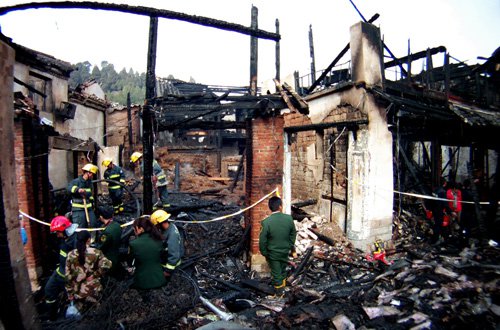|
 |
|
AFTERMATH: Xianwen Ally in the Old Town of Lijiang was damaged during a runaway fire on March 12, 2013 (CFP) |
The phrase "Chinese fire drill" may come as a joke to Westerners, but in China, where towns and relics thousands or hundreds of years old stand at risk of being lost to devastating fires, it is no laughing matter.
In April, Lijiang in south China's Yunnan Province, a popular tourist destination for its unique ethnic flavor, witnessed three fire mishaps on the 6, 10, and 14, respectively. The frequency of incidents shocked the nation and aroused anxiety over the protection of the ancient town.
Prior to the recent string of incidents, in the years from 2009 to 2013, the Old Town of Lijiang was hit by one fire per year on average. In fact, it is not the only well-known site that has erupted in flames. Earlier this year, fires broke out in two other ancient building groups—Baojing Dong Village in Guizhou Province and Dukezong Ancient Town at Shangrila County of Yunnan Province.
Fires have become the greatest threat for these cultural relics. Discussions on how to take better measures to protect them from such disasters are in full swing across China.
The Old Town of Lijiang was included in the World Heritage List in December 1997. Located in Lijiang City, most of the old town's buildings are made of wood.
The town, where the Nakhi people reside, has a history of more than 800 years. In ancient times, the town used to be the most important place on the Ancient Southern Silk Road, also called the Ancient Tea and Horse Road. It is famous for its winding cobblestone streets and orderly system of waterways and bridges.
Difficult containment
Xia Wei arrived in the Old Town of Lijiang to open a bar and restaurant in 2010. The fire on April 6 broke out only 200 meters away from his business.
When fire started at four o'clock that morning, Xia immediately grabbed an extinguisher and rushed to the site. But the fire was too big to be easily contained. He recalled that his friend's hotel was burned to the ground.
Like most business owners, Xia loved the town and enjoyed his life there. He, too, was anxious about fire hazards in the area.
As far as Xia saw it, the fires were not just coincidental. "Every building is packed close to its neighbors, and all of them are made of wood. It is dry and windy here, because Lijiang is located on a high plateau. These buildings are vulnerable to fires," he said.
Excessive commercialization served as another reason for the big loss in the fires. The stores were erected one after another, attracting large crowds. This crowdedness made it difficult for fire engines to make their ways through the narrow roads to the fire site.
The frequent fires alarmed businesspeople such as Xia. After the incident last March, he bought fire insurance for his two stores and equipped them with more fire extinguishers.
His concerns over the inefficiency of firefighting were shared by Mao Bo, Fire Chief of Gucheng District, Lijiang. Mao is in charge of fire service in Lijiang.
"The infrastructure is very weak," said Mao. "For example, the water used for firefighting and the water used for daily life share the same pipe, the diameter of which is very small."
Based on the current fire control rules, some buildings in the ancient town shouldn't have been used as places for entertainment. However, many turned a deaf ear to the warnings, said Mao.
According to the Lijiang Municipal Tourism Bureau, the city received more than 20 million tourists in 2013, up 30 percent from the previous year. Tourism brought an income of about 28 billion yuan ($4.47 billion), up by 32 percent. Along with this was the rapid increase in the number of property owners, which now totals around 100,000.
| 